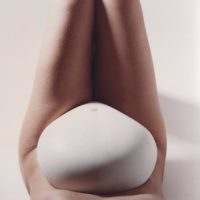projeto macunaíma, 1999
-
belly’s place
1999 C-Print 18 x 14 in.
Photography by Eduardo Camera
By Viviane Matesco – Fragments of an eternal memory
The Carrara marble sculptures of Angela Freiberger signal the maturity of a trajectory marked by a subversion of norms imposed by an academic education. Through voracious production, the artist has undergone a process of rupture in which she investigated the limits of bimensionality and the possibilities of sculptural creation. Her materials of choice – plaster and, later, paraffin – explored the idea of impression, of molding, of positive/negative (thus betraying her roots as an engraver). In the first of these, the marks and residues of objects were imprinted on their plaster casings. The paraffin pieces affirmed the notion of form, of rendering absence in visible terms. The choice of marble restrains the excess hinted at in her early work; now, the rhythm is cadenced, allowing for an elaboration of earlier investigations. From precarious and “gentle” materials which favor transformation, flux and the evidence of passage from one state to another, to a material which must be worked with obstinate physical vigor in order to register external marking, everything conspires towards greater concentration .
As a material, marble suggests carnality not only by virtue of its texture but also through the memory of its classical utilization; our imaginary is inhabited by galleries of human figures which evoke a distant temporality. “Head place”, “Belly place”, and “Hand place” are sculptures which speak of the body in multiple senses. Shape takes on a double meaning: first, an association with specific body parts. These are fragments of marble based on the artist’s own body, as though they were clothing or resting places. Eternal molds, these elements function as permanent records, and the use of marble in tombstones is no mere coincidence. However, these sculptures also refer to places of ablution and purification: baptismal fonts, wash basins, urinals, bidets. Through the occurrence of fluids and the possibility of purification, the body signals both life and death.
It centralizes opposite references such as rites of baptism and burial or the relationship between spirit and matter; it becomes a place of passage and purification and, above all, of memory facing the dilemma of human finitude. These works determine a place of lack: more than rendering the body’s presence, it is the body’s absence which is eternalized here. More than anything, they speak of the memory of something lost. Throughout Angela Freiberger’s trajectory, as much through the impregantion of the works in plaster, as in the paraffin molds, the subjects of vestige, of trace or memory monopolize her attention. In “Gravestones”, the installation With which she participated in the 1997 Havana Biennial, this concern was already evident; it was composed of rows of gravestone-like plaster molds which bore photographs of relatives killed in the Nazi holocaust.
Photography is another medium employed by the artist. In the present exhibition it bears witness to the encounter between fragments of marble and the body parts whence they originated. Freiberger considers the photographs to be part of the work, not a mere record of it. The images explore the relationships between the textures and tonalities of marble, skin and fabrics. Drapery, her most recent interest, is likewise an element which dresses and envelops the body, present here through scars and tattoos impregnated with memory. It does not intended as an idealization but as a specific place the name and address of which is invested with personal history.
Subjectivity, the weight of reminiscence and personal reference situate Angela Freiberger’s work within the perspective of contemporary art. There is no longer any room in the modern artist for shyness about his own lived experience. In seeking an autonomous artistic language, modernity rejected all links with content external to plastic values.
This becomes clear when we compare these sculptures with the works of Brancusi, for instance. Some formal relationships might be established, but resemblance would not go beyond these. Brancusi sought the essential form of universal ideas of nature, distancing himself from realism, from a · classical posture. Whether in her choice of materials, through the representation of the body, or in her employment of drapery, it is precisely in its recovery of classicism that Angela Freiberger’s work points to an opposite direction. Now, however, classicism is filtered through a contemporary gaze, with a thirst for history, for another time, as distant as it is eternal.
Viviane Matesco translated by Stephen Berg September 1999
